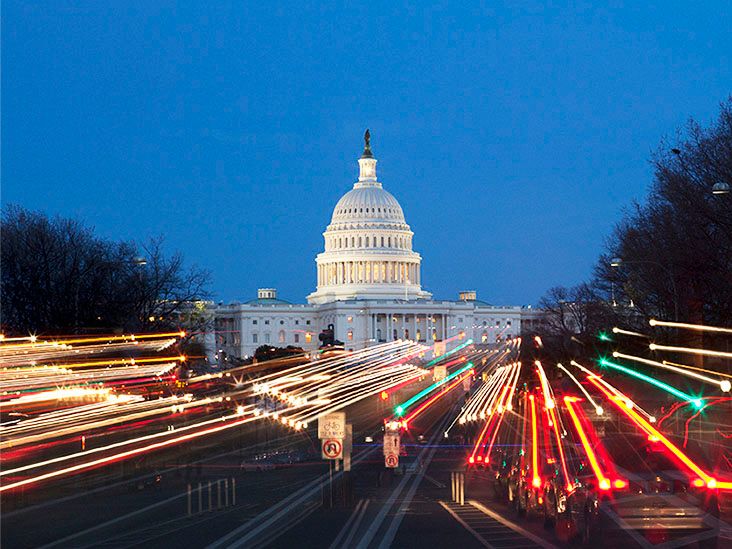- Excessive exposure to light pollution at night may raise the risk of developing Alzheimer’s disease.
- Researchers found that in people 65 and younger light pollution had a stronger correlation to Alzheimer’s disease prevalence than any other risk factor studied.
- Experts say more research is needed to fully determine if light pollution is a risk factor for Alzheimer’s disease.
Excessive light pollution at night could increase the risk of Alzheimer’s disease, particularly for people under 65.
Research published in Frontiers in Neuroscience found exposure to light pollution at night time could be an important modifiable risk factor to investigate in Alzheimer’s disease.
“We show that in the U.S. there is a positive association between [Alzheimer’s] prevalence and exposure to light at night, particularly in those under the age of 65,” Robin Voigt-Zuwala, Ph.D., first author of the study and an associate professor at Rush University Medical Center
“Nightly light pollution – a modifiable environmental factor – may be an important risk factor for [Alzheimer’s],” he said.
In undertaking their research, the study authors used data from satellites to determine the average night-time light intensity in the U.S. between the years 2012–2018.
They ranked the lower 48 U.S. states according to their average nighttime light intensity. The states were then split into five groups, from the darkest states at night with the lowest average light intensity to the brightest states at night with the highest average light intensity.
The researchers also gathered Medicare data to determine the prevalence of Alzheimer’s disease in those states.
They found statistical differences between the states that were the darkest at night and the brightest at night. Higher intensity of light pollution at night was positively associated with the prevalence of Alzheimer’s disease.
That effect held for people under and over the age of 65, for both men and women and for all races studied except for Asian Pacific Islanders.
They found that for people who were ages 65 and older, the prevalence of Alzheimer’s disease had a stronger correlation with nighttime light pollution than other potential disease risk factors like chronic kidney disease, alcohol abuse, depression, and obesity.
But for this group, there were some risk factors that had a stronger correlation with Alzheimer’s disease than light pollution. These included high blood pressure, diabetes, and stroke.
In people aged under 65, the study authors found that a higher intensity of light pollution at night was associated with a greater prevalence of Alzheimer’s disease than any other risk factor studied.
The study authors note their research has some limitations. The Medicare data was limited, the study examined prevalence of Alzheimer’s but not incidence and no indoor light data was available.
“Indoor light exposure (e.g., televisions, computers, phones) is critically important and should be evaluated in future studies,” the study authors write. “The totality of outdoor and indoor nighttime light exposure is important to consider to fully understand the impact of nighttime light on [Alzheimer’s].”
Nikki-Anne Wilson, Ph.D., a University of New South Wales Postdoctoral Research Fellow and Conjoint Postdoctoral Research Fellow at Neuroscience Research Australia (NeuRA), who was not involved in the study, said that while it remains to be seen if nighttime light exposure is truly a risk factor for Alzheimer’s, sleep may be an important piece of the puzzle.
“Research investigating dementia, and factors which contribute to its development, is continuing to evolve as we address emerging issues in our environment. It is too early to say whether light pollution may contribute to dementia risk. However, we do know that the development of good sleep habits is associated with broader health benefits,” she told Medical News Today.
“Things like limiting screen time before bed, using curtains to shut out external light where possible, and maintaining a consistent sleep schedule are simple ways to improve sleep. Importantly, if you are experiencing considerable daytime sleepiness or symptoms of a sleep disorder, it is always best to get checked by your doctor.”
— Nikki-Anne Wilson
The researchers note there are numerous potential mechanisms through which nighttime light pollution may impact Alzheimer’s disease.
One of them is the role of sleep disruption. Wilson says the impact this can have on the brain’s processes is an important factor to consider.
“We know that sleep plays an important role in clearing the protein associated with Alzheimer’s disease, known as amyloid-beta, from the brain. If sleep is disrupted, by things such as light or an untreated sleep disorder such as sleep apnoea, the ability for our brain to clear this protein is reduced. Further, poor sleep quality may have a broader impact on other risk factors, such as depression, level of physical activity, and high blood pressure,” she said.
In the United States, in 2024, roughly 6.9 million Americans ages 65 and older live with Alzheimer’s. Of those, 73% are 75 years of age or older.
In most people, the exact cause of Alzheimer’s disease is not fully understood. But scientists believe it is likely a complex combination of genetic, health, and lifestyle factors, together with age-related changes taking place in the brain.
Some risk factors, like age and family history, can’t be changed. However, some risk factors believed to be associated with Alzheimer’s disease may be modifiable.
These include smoking, misuse of alcohol, physical inactivity, poor sleep, unhealthy diet, social isolation, and a lack of mental stimulation.
Clifford Segil, DO a neurologist at Providence Saint John’s Health Center in Santa Monica, California, who was also not involved in the study, said that more research is needed to determine if nighttime light exposure is a risk factor for Alzheimer’s.
“It is challenging as a neurologist to agree that patients who stay up at night doing things with lights are going to increase their risk later in life to get Alzheimer’s dementia. Nighttime light exposure is not an accepted dementia risk factor and it will take a lot more than a single article like this to add this to the battery of risk factors we currently assess in patients being diagnosed with dementia by neurologists,” he told MNT.
The researchers note that in some places around the world, particularly urban centers, lights never go off.
“Today, most people living in urban and suburban areas are unable to see natural celestial light due to light pollution and as much as 80% of the global population experience light pollution. Although artificial light at night is considered by most to be harmless or even beneficial (e.g., safety), light pollution has detrimental ecological, behavioral, biological, and health consequences,” they write.
They are hopeful their findings raise awareness of some of the possible risks associated with exposure to light at night.
“Awareness of the association should empower people – particularly those with risk factors for [Alzheimer’s] – to make easy lifestyle changes,” said Voigt-Zuwala in a press statement. “Easy to implement changes include using blackout curtains or sleeping with eye masks. This is useful especially for those living in areas with high light pollution.”













